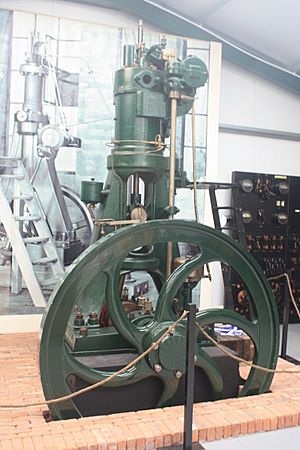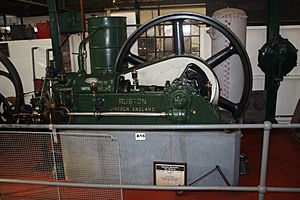Anson Engine Museum facts for kids
The Anson Engine Museum is a special place in Poynton, Cheshire, England. It is built on the site of an old coal mine called Anson Colliery. The museum started because two friends, Les Cawley and Geoff Challinor, loved collecting and showing stationary engines. These are engines that stay in one place, like those used in factories or mines. Today, the Anson Engine Museum has one of the biggest collections of engines in all of Europe. You can also find a working blacksmith's shop, a carpentry shop, and a café there.
Contents
Where to Find the Museum
The Anson Engine Museum is located in Poynton, Cheshire, England. It sits on the land where the old Anson coal mine used to be.
A Look Back: History of the Site
Coal Mining at Anson
Coal has been found and dug up in the Poynton area for a very long time. Records show that coal mining was happening here as early as 1589. At first, miners dug coal from the surface or from shallow holes. Later, deeper shafts were dug. To help with the mining, waterwheels or stationary steam engines were used. These engines helped pump water out of the mines and lift coal to the surface.
In the 1800s, the Poynton coal mines became very important. The Warren family owned the rights to the coal. In 1832, Lord Vernon decided to manage the mines himself. By 1859, the mines were producing a huge amount of coal. The Anson Pit was one of the main mines working at this time. The Poynton collieries finally closed on August 30, 1935. About 250 miners lost their jobs then.
The Anson Pit Story
The Anson Pit, also known as Lower Anson, was an active coal mine. In 1826, it had a Newcomen atmospheric engine that helped lift things. By 1847, 36 men and 6 boys worked there. They dug for coal at depths of up to 132 yards. The pit later used a 16 horsepower engine.
In 1853, miners dug even deeper, reaching 191 yards. By 1856, the Anson Pit was producing 170 tons of coal every day. In 1869, a new, more powerful engine was installed to lift coal. This engine was still working when the pit closed in 1926. Another engine was added to pull coal tubs up a long, sloped tunnel inside the mine. These engines were powered by steam from large boilers.
Today, the Anson Engine Museum stands on the exact spot of the old Anson Colliery.
How the Museum Began
The museum is the dream come true for Les Cawley and Geoff Challinor. They started collecting stationary engines as a hobby. As their collection grew bigger and bigger, they decided to open a museum. In 1986, they formed a charity and began building the first museum structure.
The Anson Engine Museum first opened its doors to visitors in 1989. For many years, it only opened on certain days. In July 2002, Les Cawley passed away. Geoff Challinor then worked even harder to make the museum a place that would attract visitors from all over the world.
Amazing Engines on Display
Famous Engine Makers
The museum features some of the very first engines made by famous companies like Crossley and Mirrlees. The city of Manchester, near the museum, was a hub for making stationary engines. By the early 1900s, more than 20 engine makers were located within 20 miles of the museum.
Companies like Mirrlees, Bickerton & Day focused on diesel engines. L Gardner & Sons became famous worldwide for their small, fast, and high-quality diesel engines. Crossley Brothers worked with the ideas of Nicolaus Otto. The museum mainly focuses on engines made by these local manufacturers.
Must-See Engines
The Anson Engine Museum has one of the largest collections of engines in Europe. It draws engine fans from all over the world. In recent years, the museum has won awards for its displays, its helpful volunteers, and some of its amazing engines.
Some of the most popular engines you can see include:
- The largest working example of a Crossley Atmospheric gas engine.
- An award-winning, original L Gardner & Sons L series engine. It even has a special plaque from the Institution of Mechanical Engineers.
- The oldest diesel engine in the UK, which is the Mirrlees No. 1.
- The original Crossley No. 1 engine.
- A special area with steam engines, including a Stott cross-compound mill engine and a Fowler beam engine.
- A very rare Griffin 6-stroke engine.
- A rare Atkinson cycle engine.
- A Crossley over-hung crank engine.
- A Hugon gas engine.
- A huge 63-ton Ruston & Hornsby engine that was once used at Ealing Studios.
See Also
- Internal Fire - Museum of Power
- Prickwillow Museum - a collection of large diesel pumping engines
- List of museums in Cheshire




